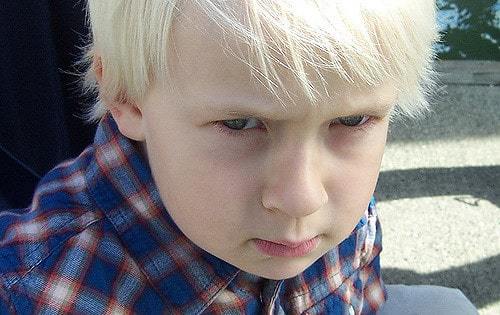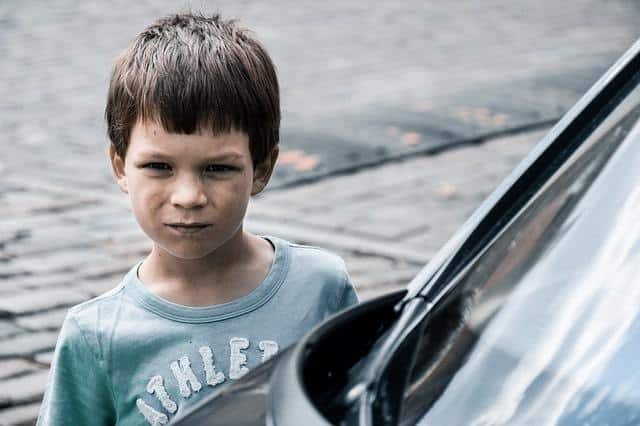Anger can look different for every child, but some common anger symptoms in children are irritability, yelling, crying, negotiating, and talking back or being disrespectful with parents.
As children become teens, the back-talk turns into more ferocious arguments and more rule-breaking behavior, like sneaking out of the house or violating other house rules.
There are differences between normal, healthy expressions of anger and behavior that signals that a child may need help from a professional to learn how to handle the emotion appropriately.
Table of Contents
What’s Normal and What’s Not?
A child’s main job during development is to begin to understand the world around them and develop a healthy sense of how to handle the feelings that result in various experiences.
Because of this, it is necessary for a child to feel every emotion to practice expressing them in healthy ways once they are grown.
It’s certainly important for children to test out lots of different ways to express all of their emotions — trial and error is a great learning tool for children and one they will continue to use as they grow into adulthood.
Learning from our mistakes is a major part of life. When a child handles their anger in a way that seems excessive, it is not a bad thing but is something that needs to be used as a teaching moment, so they can begin to understand the boundaries around their emotional expression.
Parents help model and teach children about anger, both in the way they respond to their child’s anger and in the way they express their own anger.
It’s important for parents to have a good grasp on how they are handling both of these situations to better understand how to help their child if anger becomes problematic and impacts the everyday life of their child.
But, how does a parent know what is normal and what is problematic and in need of professional help?
Normal Anger in Childhood
Here is a list of some behaviors that would be considered developmentally appropriate for children:
- General irritability, angry non-verbal expressions, and body language
- Tantrums (screaming, crying, whining, yelling, etc.)
- Swatting, mild hitting behavior, sometimes biting
- Throwing toys, food, etc.
- Stomping feet
- Throwing themselves on the floor
- Talking back, saying mean or disrespectful things to parents or other adults
- Grabbing toys or other preferred items from peers or adults
**Note: While these are considered typical patterns of behavior in children, using the tips in the “How Can I Help My Child?” section below can help to alleviate these angry behaviors.
Childhood Anger that May Require Professional Assistance
Here is a list of angry behaviors that are considered more extreme than typical child anger and may call for you to speak with a professional regarding how to help your child learn to manage their anger in a healthier way:
- Angry outbursts and tantrum behavior do not lessen over time and continue well past the developmental age when most children stop these behaviors. A child past the age of eight continuing to exhibit tantrum-like behavior may need professional assistance to work through the triggers and the reasons why this is continuing.
- Any aggressive behavior that could hurt themselves or someone else. This includes persistent biting behavior, hitting, or scratching, among other aggressive behaviors.
- Frequent destructive behavior that damages property or puts the child or others in an unsafe situation.
- Persistent patterns of emotional stress as a family unit as a result of a child’s anger. High conflict in the home that is rooted in a child’s angry outbursts may need outside assistance to manage and improve family life.
- Problems at school or daycare — persistent discipline due to angry outbursts affecting their academic performance or their ability to stay enrolled in a school or daycare program. Often suspensions or expulsions can happen as a result of frequent attempts to redirect a child’s anger outbursts.
- Peer difficulties or inability to have positive social experiences with peers due to a child’s anger. This may be seen as other children refusing play dates, or your child complaining that no one wants to play with them, only to find out that they are angry and mean to other children, thus decreasing their desire to connect.
- Any self-deprecating statements that suggest that a child feels guilty or has begun to connect their anger to their self-worth. Common ways parents notice this is when their child says something like, “I’m a terrible person,” or “I’m a bad kid because I only do bad things,” or “No one likes me because I don’t do anything right.”
**Note: If you are noticing or experiencing these symptoms with your child, it is recommended that you seek assistance from a mental health professional to help decrease angry behaviors.
Normal Anger in Teenagers
By adolescence, most of the above behaviors are likely to have been decreased, but often are replaced by more developmentally appropriate expressions of anger, including:[2]
- Decreasing amount of personal information shared with parents
- Arguing, yelling, cursing, verbal outbursts, etc.
- Overdramatizing or over-personalizing conflict with family
- Slamming doors
- Walking away and refusing to communicate
- Spending more time away from home
- General irritability, moodiness, sullen or angry non-verbal expressions, closed-off body language
- Not following household rules and deliberately defying parents’ wishes and expectations.
** Note: Similar to the child section, any parent can use the tips in the “How Can I Help My Child?” section below to help improve their child’s ability to manage anger.
Teenage Anger That May Require Professional Assistance
Here is a list of angry behavior that teen’s exhibit that may suggest that they are in need of professional help to learn how to express and manage their anger in a healthier, more appropriate way:
- Aggressive, physical interactions with parents, other adults, and peers as well. Fights at school or pushing/shoving/hitting at home are definite causes for concern.
- The frequency and duration of conflicts at home continue to increase and escalate with no end in sight. Teens continue to increase the intensity of the arguments, not backing down, and re-engaging even if a parent has tried to disengage from the situation to calm themselves down.
- A teen’s reaction level does not equal the level of the problem and appears that they are responding significantly more severely than would be necessary for the situation. An example of this would be a parent asking their teen to set the table and the teen exploding in anger, calling a parent names and slamming their door. If a pattern of explosive anger like this is occurring, outside assistance is suggested.
- Consistent patterns of oppositional and defiant behavior that involve a child breaking family rules or even breaking the law in general. Sneaking out, breaking curfew, alcohol/drug consumption or other illegal behaviors, all are concerning behaviors that may require assistance.
- Academic problems, both conduct-related or scholastically. This may include suspensions or expulsions for behavior-related difficulties, including angry outbursts; it could also involve disruptive behavior and an inability to improve behavior after consistent redirection by teachers and administrative staff. Decreased demonstration of academic ability can also result from a child experiencing irritability or anger and needs to be addressed to help improve the teen’s learning.
- Social problems — fights, withdrawing socially, appearing disconnected from a close network of peers, or expressing hatred or resentment for their peer group are signs that a child is struggling with concerning anger.
- Violent behaviors — any excessive or obsessive focus on violence including weapons, games, or actual physical violence is something that should be monitored and addressed immediately. Threats, bullying, or general cruelty to other people or animals is immediately concerning and also requires prompt attention.
- Signs of other mental health issues — anger is often a secondary emotion, especially as children grow. As teens, it’s important to assess other mood shifts and ways they continue to express emotions to confirm whether or not their anger is masking other symptoms, such as depression, anxiety, or another mental health condition.
**Note: If you are noticing or experiencing these symptoms with your child, it is recommended that you seek out assistance from a mental health professional to help decrease anger behaviors.
What Conditions May Cause Anger?
Anger is an emotion that is often a result of a child (or adult) feeling some sort of distress or discomfort with a present situation. Because anger is a fiery emotion that is easy to misuse, it coincides with many mental health conditions.
A person who struggles with a mental health diagnosis may express symptoms of difficulty regulating and managing their thoughts, feelings, and behavior in appropriate ways, so anger is often a good indicator that someone may be struggling and in need of professional assistance.
Here is a list of common mental health conditions that are associated with symptoms of anger:
Oppositional Defiant Disorder
(ODD[3] A child may be diagnosed with ODD if they exhibit a pattern of angry or irritable mood/behaviors for over 6 months. Behaviors include losing temper, exhibiting tantrum behavior, being angry and resentful, arguing with authority figures/adults, vindictiveness, and blaming behavior.
Click HERE if you suspect your child has ODD
Conduct Disorder
In more severe situations, a teen (or even sometimes a child) may meet the criteria for a conduct disorder,[4] which is defined as involving the following behaviors being present for at least 6 months:
- Aggression to people and animals
- Destruction of property
- Deceitfulness or theft
- Serious violations of rules and laws
Trauma (Posttraumatic Stress Disorder)
Neglect, abuse, and other forms of trauma can affect children in lots of ways, but a common way that children express their distress about these situations is to act out with anger and aggression.
This can help them to mask the sadness, pain, and hurt they are feeling and allow them to feel that they have a sense of control when they can feel so helpless in other situations in their lives.
Click HERE if you suspect your child has PTSD
Anxiety
Anger is often used to mask other emotions, thus children often use anger to cover up feelings of worry, fear, or anxiety.
Often times kids and teens alike will lash out in anger or refuse to do something, not as a general act of defiance, but because they are feeling anxiety that is causing them to avoid whatever is triggering them.
Click HERE if you suspect your child has anxiety
Depression
A common side effect of depression is anger and irritability. This may be more common in teens, but can also be seen in children. Often children who are self-critical and seem to be “down” on themselves or give themselves a hard time will express their frustrations with angry outbursts.
This is often accompanied by shame and self-loathing that can cause children to experience a decreased interest in preferred and enjoyable activities, can cause them to isolate from their peers and family, and can cause them to experience difficulties in regulating eating, sleeping, concentration, and many other things in their lives.
Click HERE if you suspect your child has depression
Attention-Deficit Hyperactivity Disorder (ADHD)
Children who have been diagnosed with ADHD struggle severely with managing their impulses and regulating their behavior, so anger is a common emotional response exhibited by inappropriate behavior.
Often their inability to follow through with tasks or to fully comprehend and attend to instructions increases the likelihood of being redirected, which in turn may increase the likelihood for frustration and angry outbursts.
Click HERE if you suspect your child has ADHD
Learning Disorders and Other Processing Difficulties
Visual or auditory processing issues, sensory integration issues, and autism spectrum disorders can also increase angry outbursts and behaviors.
Kids who do not know how to express themselves or are experiencing difficulty regulating their bodies have a much harder time exhibiting appropriate frustration tolerance.
Click HERE if you suspect your child has an autism spectrum disorder
Can Other Things Cause Angry Behavior?
Anger is so interconnected to our thoughts, feelings, and behavior that there are many reasons a child latches on to anger and uses it to express himself or herself.
Aside from mental health conditions, there are other things that may increase the likelihood of a child developing difficulty with anger management. Here’s a list of some common coinciding events that may exacerbate angry responses in children:
Family Dysfunction
Children who live in high-conflict homes can be experiencing emotional dysregulation that can present in angry or aggressive ways.
Anger can help a child to feel in control in situations when they feel helpless, and high-conflict homes are definitely a place we see this.
Peer Problems
It’s often discussed that bullies do not become bullies without some experiences making them feel insecure, unloved, or unwanted. Bullying behavior develops as a result of a child (or adult) feeling inadequate about themselves and wanting to feel some semblance of control over others to help them feel better, stronger, and more capable.
Anger can often coincide with bullying behavior and can also begin as a result of being bullied. Anger outbursts can also cause struggles with “fitting in” to a peer group, which, in turn, can also impact a child’s ability to handle disappointing peer interactions in an appropriate way.
Medical Concerns
While much less common, it is possible that some children may have a medical condition that could be impacting their ability to regulate their emotions. Occasionally children experience neurological impairments or other medical diagnoses that can account for changes in mood and inability to regulate and appropriately express their anger.
How Can I Help My Child?
Whether your child is exhibiting appropriate anger responses or more severe ones, parents’ responses to anger are the most important way that children learn what is acceptable and appropriate behavior and what is not.
Children thrive off the reinforcement they receive from their parents. If you continue to reinforce inappropriate anger responses in inconsistent, unpredictable, or even counter-intuitive ways, these behaviors will continue.
However, if you’re able to set up a consistent and predictable way of responding to and redirecting your child’s anger, you will be able to help them decrease or eliminate negative anger responses, which will help them significantly as they grow. Here are some tips:
1. Normalize anger

It’s also important for kids to begin to understand the connection between what they’re feeling and how they’re conveying it. Parents should help children label their feelings as they express them to help them begin to connect the fact that feelings often result in behavior other people notice and respond to.
Saying, “I can tell that you’re angry because…” and describing body language or behavior can be helpful to begin to understand their reactions.
2. Discover and connect triggers to outbursts
Understanding your child’s typical responses will help you identify when certain things may be “triggering” their anger. You can address it by helping them to problem-solve how to fix the trigger or how to tolerate frustration when it can’t be fixed.
3. Stay aware of how you reinforce the behavior
Every behavior that becomes a pattern is one that is being reinforced in some way. For children, it often doesn’t matter if this reinforcement is with positive or negative attention to their behavior.
More often than not, a child’s angry outburst will be met with equal or more reinforcement to get the child to stop (saying “no!”, yelling, punishing/consequences, etc). While our impulse is to redirect the behavior using this strategy, this still reinforces the behavior and may cause it to continue.
Instead, try to eliminate any big responses to anger and walk away until your child is calm. Then, once calm, you can provide reinforcement and praise for their ability to regulate and discuss the appropriate way to handle angry feelings next time.
**See “Is My Child’s Defiance Normal?” article for more information on appropriate ways to redirect inappropriate behavior under How Can I Help My Child section.
4. Model appropriate anger management
Obviously, children are little sponges who soak up everything you do or say. They learn everything from you, so if you have a hard time managing your anger without inappropriate outbursts, why wouldn’t your child be the same?
Teaching a child coping skills to manage their anger (deep breathing, exercise, walking away from conflict, meditation/mindfulness, etc.) can help them have additional tools to use the next time they’re angry.
Telling them not to respond in a certain way doesn’t tell them what they should do, which is crucial. Teaching children how to expel anger in appropriate ways is also important.
This may include using a punching bag or pillow, writing feelings out, or any other strategy used to get negative energy out of their bodies to reduce anger.
5. Know when to ask for help
Anger can escalate quickly and can become a life-long problem for a child if it is not worked through early in their life.
If you notice your child struggling, seeking help from a trained professional is the best way to help your child and your family find appropriate ways to cope that will help to develop long-term changes in your child’s emotional responses.
What Can I Expect in the Future?
For children with more severe anger, not seeking assistance could mean an increase in the severity of these behaviors and escalated problems in their future that could result in long-term or lifelong consequences.
Should you seek professional help, it is likely that your child can learn new ways to cope with anger and learn how to express it in healthy and appropriate ways.
Using the suggestions above is a great start, as these are tips that have been shown to help alleviate both typical and untypical anger behaviors in children.
A neutral party to help you problem-solve exactly how to execute these tips can be additionally helpful in personalizing and making them work for your family.
The process of raising angry children can be stressful and hard to navigate, but everyone has to learn how to manage anger.
While it is challenging and stressful, there are many ways parents and professionals can help kids turn their anger around and improve the quality of life for the child and the entire family, as well.
What to Expect When Seeking Help
Many mental health professionals who specialize in working with kids and families have expertise in dealing with anger and excessive angry outbursts because this is a very common reason parents seek treatment with their children.
A professional trained in dealing with excessive childhood anger will help you understand the possible triggers and reasons behind the anger and will help you develop a personalized plan to help your child both cope with their big angry feelings and also learn how to express them appropriately.
This will take place through behavior therapy, designed to help kids learn new ways to catch their emotions before they get too intense and redirect them into an appropriate alternative.
These professionals will also work with parents to help develop a plan that will set your child up for success in practicing and using these skills and to address any ways to improve parenting to reinforce appropriate responses, as well.
It’s possible that in more extreme situations, a child may be referred to a psychiatrist or pediatrician who will discuss medication as an option to help treat mental health conditions that may be exacerbating anger.
These professionals can assess any biological or neurological struggles that may be impacting a child’s ability to emotionally regulate.
Creating a team to help tackle your child’s anger issues can help you feel less alone in dealing with these behaviors, less helpless, and more confident in the plan and possibility for improvement of your child’s overall functioning.
References
- Raymond DiGiuseppe, Raymond Chip Tafrate, Understanding Anger Disorders, Oxford University Press, 2006, pp. 133–159.
- American Psychological Association. (2002). Developing Adolescents.
- American Psychiatric Association. (2013). Oppositional Defiant Disorder. In Diagnostic and statistical manual of mental disorders (5th ed.). Washington, DC: Author.
- American Psychiatric Association. (2013). Conduct Disorder. In Diagnostic and statistical manual of mental disorders (5th ed.). Washington, DC: Author.







